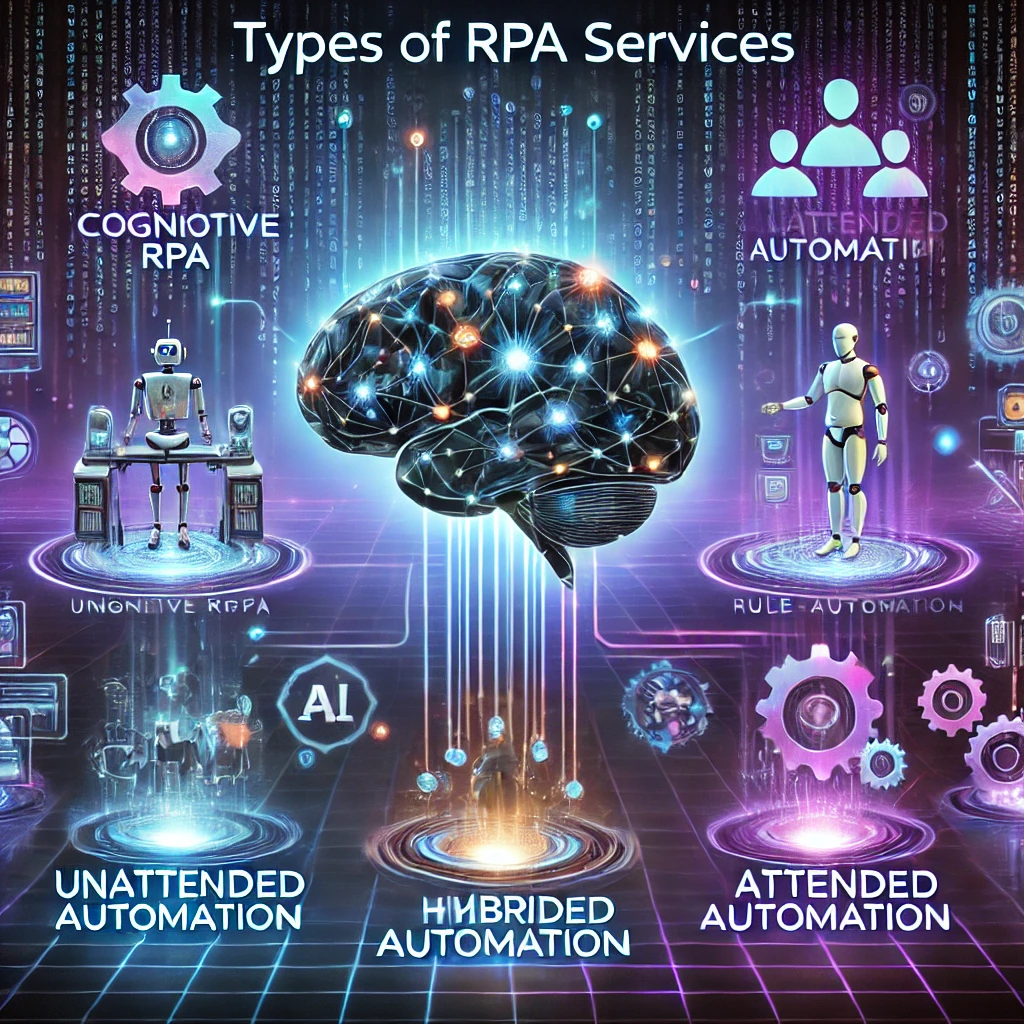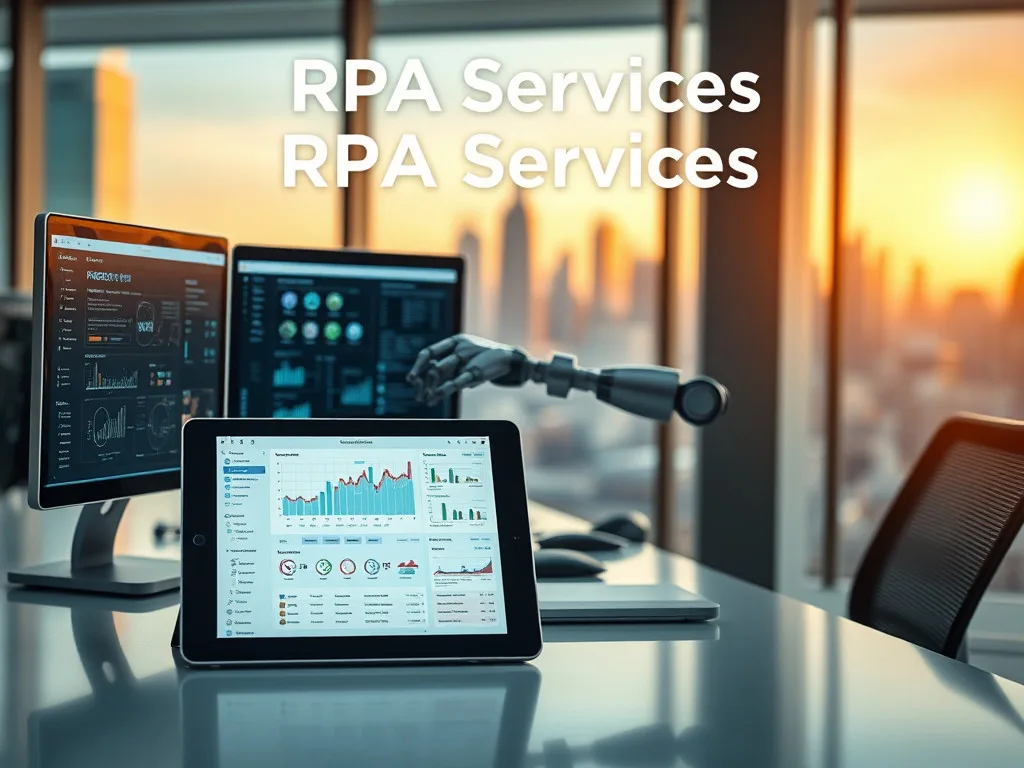Table of Contents
Introduction
Have you ever felt overwhelmed by repetitive tasks that consume your workday? 🤖 Imagine a world where mundane, time-consuming activities are handled effortlessly, allowing you to focus on what truly matters. Welcome to the realm of RPA services – your gateway to enhanced productivity and streamlined operations.
In today’s fast-paced business environment, efficiency is king. Robotic Process Automation (RPA) services are revolutionizing how companies operate, offering a powerful solution to automate routine processes and free up valuable human resources. But what exactly are Robotic Process Automation (RPA) services, and how can they transform your organization?
Join us as we dive into the world of Robotic Process Automation services, exploring their types, implementation strategies, and industry applications. We’ll guide you through choosing the right provider, overcoming challenges, and even peek into the future of this game-changing technology. Get ready to unlock the potential of RPA and propel your business into a new era of efficiency and innovation! 🚀

Understanding Robotic Process Automation (RPA) Services
A. Definition and core concepts
Robotic Process Automation (RPA) services refer to the use of software robots or “bots” to automate repetitive, rule-based tasks traditionally performed by humans. These services leverage artificial intelligence and machine learning technologies to streamline business processes, increase efficiency, and reduce errors.
Key concepts in RPA include:
- Automation: The core principle of Robotic Process Automation (RPA), involving the execution of tasks without human intervention
- Bots: Software programs designed to mimic human actions in digital systems
- Process mapping: Identifying and documenting tasks suitable for automation
- Scalability: The ability to deploy RPA solutions across various departments and processes
B. Key players in the RPA market
Several companies have emerged as leaders in the RPA market. Here’s a comparison of some top RPA service providers:
| Provider | Key Features | Industry Focus |
|---|---|---|
| UiPath | User-friendly interface, strong AI capabilities | Finance, Healthcare |
| Automation Anywhere | Cloud-native platform, extensive bot marketplace | Insurance, Retail |
| Blue Prism | Enterprise-grade security, centralized control | Banking, Telecommunications |
| Microsoft Power Automate | Seamless integration with Microsoft ecosystem | Cross-industry |
C. Common use cases
Robotic Process Automation services find applications across various business functions. Some popular use cases include:
- Data entry and validation
- Invoice processing and accounts payable
- Customer onboarding and KYC processes
- HR tasks such as employee onboarding and payroll management
- Inventory management and order processing
D. Benefits for businesses
Implementing RPA services offers numerous advantages to organizations:
- Increased productivity: Bots can work 24/7 without breaks, significantly boosting output
- Cost reduction: Automating repetitive tasks reduces labor costs and minimizes errors
- Improved accuracy: RPA eliminates human errors in data entry and processing
- Enhanced compliance: Automated processes ensure consistent adherence to regulatory requirements
- Scalability: RPA solutions can be easily scaled to meet growing business needs
With these benefits in mind, it’s clear why RPA services have gained significant traction across industries. Next, we’ll explore the various types of RPA services available to businesses looking to leverage this technology.

Types of RPA Services
When it comes to Robotic Process Automation (RPA), various types of services cater to different business needs and complexities. Let’s explore the four main categories of RPA services:
A. Cognitive RPA
Cognitive RPA combines traditional RPA with artificial intelligence (AI) and machine learning capabilities. This advanced form of automation can handle complex, unstructured data and make decisions based on learned patterns.
Key Features:
- Natural Language Processing (NLP)
- Machine Learning algorithms
- Image and speech recognition
B. Hybrid Automation
Hybrid automation integrates Robotic Process Automation with other automation technologies, creating a powerful synergy between human workers and software robots.
| Component | Role |
|---|---|
| RPA Bots | Handle repetitive tasks |
| Human Workers | Manage exceptions and complex decision-making |
| AI/ML | Provide intelligent insights and predictions |
C. Unattended Automation
Unattended automation operates without human intervention, making it ideal for high-volume, rule-based processes that run in the background.
- Runs 24/7 without human supervision
- Perfect for batch processing and data entry tasks
- Scalable for enterprise-wide deployment
D. Attended Automation
Attended automation works alongside human employees, assisting them in their daily tasks and improving overall productivity.
- Desktop-based robots
- Triggered by user actions
- Enhances customer service and front-office operations
As we move forward, it’s crucial to understand how these different types of RPA services can be implemented effectively in various business processes and industries.

Implementing RPA Services
Now that we’ve explored the types of Robotic Process Automation services, let’s dive into the implementation process. Successful RPA implementation involves several key steps, each crucial for maximizing the benefits of automation.
Process Identification and Assessment
The first step in implementing Robotic Process Automation services is identifying and assessing suitable processes for automation. This involves:
- Analyzing existing workflows
- Identifying repetitive, rule-based tasks
- Evaluating potential ROI
Here’s a comparison of ideal vs. non-ideal processes for RPA implementation:
| Ideal for RPA | Not Ideal for RPA |
|---|---|
| High-volume tasks | Low-volume tasks |
| Rule-based processes | Processes requiring human judgment |
| Standardized inputs | Unstructured data inputs |
| Stable processes | Frequently changing processes |
Bot Development and Testing
Once suitable processes are identified, the next step is bot development and testing. This phase includes:
- Designing the bot’s workflow
- Coding the automation script
- Rigorous testing in a controlled environment
Deployment and Monitoring
After successful testing, it’s time to deploy the Robotic Process Automation (RPA) bots. Key aspects of this phase include:
- Integrating bots with existing systems
- Training employees on bot interaction
- Continuous monitoring of bot performance
Scaling and Optimization
As Robotic Process Automation (RPA) implementation matures, focus shifts to scaling and optimization. This involves:
- Expanding RPA to other suitable processes
- Refining existing bots for improved efficiency
- Incorporating advanced technologies like AI for intelligent automation
By following these steps, organizations can effectively implement Robotic Process Automation (RPA) services, paving the way for increased efficiency and productivity. Next, we’ll explore the various industries leveraging RPA services to transform their operations.

Industries Leveraging RPA Services
Robotic Process Automation (RPA) has revolutionized various industries, streamlining operations and enhancing efficiency. Let’s explore how different sectors are harnessing the power of RPA:
A. Manufacturing
In the manufacturing sector, Robotic Process Automation (RPA) has become a game-changer. It automates repetitive tasks, such as inventory management, quality control, and supply chain operations. Here’s a list of key Robotic Process Automation (RPA) applications in manufacturing:
- Automated order processing
- Predictive maintenance
- Production planning and scheduling
- Compliance reporting
B. Telecommunications
The telecommunications industry benefits greatly from Robotic Process Automation (RPA), particularly in customer service and network management. RPA tools help telecom companies:
- Automate customer onboarding
- Manage network performance
- Process billing and invoicing
- Handle service requests and complaints
C. Retail and e-commerce
Robotic Process Automation (RPA) in retail and e-commerce focuses on enhancing customer experience and optimizing backend operations. Key use cases include:
- Inventory management
- Price comparison and adjustment
- Order fulfillment and tracking
- Customer data analysis
D. Healthcare
The healthcare industry leverages Robotic Process Automation (RPA) to improve patient care and streamline administrative tasks. Some notable applications are:
- Patient appointment scheduling
- Claims processing
- Medical record management
- Regulatory compliance
E. Finance and banking
In the finance and banking sector, Robotic Process Automation (RPA) plays a crucial role in automating complex processes and ensuring regulatory compliance. Here’s a comparison of RPA applications in different financial services:
| Service Area | RPA Application |
|---|---|
| Banking | Account opening, loan processing, fraud detection |
| Insurance | Claims processing, policy administration, underwriting |
| Investment | Portfolio management, risk assessment, compliance reporting |
As we’ve seen, Robotic Process Automation (RPA) services are transforming operations across various industries. Next, we’ll explore how to choose the right RPA service provider to implement these solutions effectively in your organization.

Choosing the Right RPA Service Provider
Now that we’ve explored the various industries leveraging Robotic Process Automation (RPA) services, let’s focus on selecting the ideal RPA service provider for your organization. This decision is crucial for the success of your automation initiatives.
A. Analyzing support and maintenance from best RPA companies offerings
When evaluating RPA service providers, it’s essential to consider their support and maintenance offerings. The best RPA companies typically provide:
- 24/7 technical support
- Regular software updates
- Proactive monitoring and issue resolution
- Training and knowledge transfer
| Feature | Importance |
|---|---|
| 24/7 Support | Critical for minimizing downtime |
| Regular Updates | Ensures optimal performance and security |
| Proactive Monitoring | Identifies and resolves issues before they escalate |
| Training | Empowers your team to manage the RPA solution effectively |
B. Considering integration options
A key factor in choosing an Robotic Process Automation (RPA) service provider is their ability to integrate with your existing systems. Look for providers that offer:
- Seamless integration with legacy systems
- API connectivity
- Support for multiple data formats
- Compatibility with various enterprise applications
C. Evaluating technology platforms
The right Robotic Process Automation (RPA) technology platform can make a significant difference in your automation journey. Consider the following aspects:
- Scalability
- Security features
- Ease of use
- AI and machine learning capabilities
- Analytics and reporting tools
D. Assessing vendor capabilities
Finally, evaluate the vendor’s overall capabilities and track record. Key factors to consider include:
- Industry experience
- Customer references
- Implementation methodology
- Innovation and R&D investments
- Financial stability
By thoroughly assessing these aspects, you’ll be better equipped to select an RPA service provider that aligns with your organization’s needs and goals. Next, we’ll explore the common challenges in RPA implementation and strategies to overcome them.

Overcoming Challenges in RPA Implementation
As organizations embrace RPA, they often encounter several hurdles. Let’s explore common challenges and strategies to overcome them.
Handling process exceptions
Process exceptions can disrupt RPA workflows. To address this:
- Implement robust error handling mechanisms
- Create detailed exception logs for analysis
- Develop contingency plans for manual intervention
Managing bot maintenance and updates
Keeping bots running smoothly requires ongoing attention:
- Establish a regular maintenance schedule
- Monitor bot performance and error rates
- Stay informed about software updates and patches
- Test updates in a staging environment before deployment
Ensuring data security and compliance
Data protection is crucial in RPA implementation:
| Security Measure | Description |
|---|---|
| Access Control | Limit bot access to sensitive data |
| Encryption | Protect data in transit and at rest |
| Audit Trails | Track all bot actions for compliance |
| Data Masking | Hide sensitive information during processing |
Addressing employee concerns
Employee buy-in is essential for successful RPA adoption:
- Communicate the benefits of RPA clearly
- Provide training on working alongside bots
- Emphasize opportunities for upskilling and role enhancement
- Address fears of job displacement honestly
By proactively tackling these challenges, organizations can maximize the benefits of RPA implementation. Next, we’ll explore the exciting future trends shaping the RPA landscape.

Future Trends in RPA Services
As the field of Robotic Process Automation (RPA) continues to evolve, several exciting trends are shaping its future. Let’s explore these emerging trends that are set to revolutionize RPA services.
RPA-as-a-Service models
RPA-as-a-Service (RPAaaS) is gaining traction as a flexible and cost-effective solution for businesses of all sizes. This model allows organizations to leverage RPA capabilities without the need for significant upfront investments in infrastructure and expertise.
Benefits of RPAaaS:
- Reduced implementation costs
- Scalability and flexibility
- Access to expert support
- Regular updates and maintenance
Hyperautomation
Hyperautomation is emerging as a game-changing trend in the RPA landscape. It combines RPA with advanced technologies like AI, machine learning, and process mining to create end-to-end automation solutions.
| Component | Description |
|---|---|
| RPA | Automates repetitive tasks |
| AI | Adds intelligence and decision-making capabilities |
| Machine Learning | Enables continuous improvement and adaptation |
| Process Mining | Identifies automation opportunities and optimizes processes |
Cloud-based RPA solutions
Cloud-based RPA solutions are becoming increasingly popular due to their accessibility, scalability, and reduced infrastructure requirements. These solutions offer several advantages over traditional on-premise deployments:
- Lower upfront costs
- Easier collaboration and remote access
- Automatic updates and maintenance
- Improved security and compliance
AI and machine learning integration
The integration of AI and machine learning with RPA is paving the way for more intelligent and adaptable automation solutions. This combination, often referred to as Intelligent Automation, enables RPA bots to handle complex, cognitive tasks that were previously beyond their capabilities.
Key applications of AI and ML in RPA:
- Natural Language Processing (NLP) for document understanding
- Computer Vision for image and video processing
- Predictive analytics for decision-making
- Cognitive automation for handling unstructured data
As these trends continue to shape the future of RPA services, organizations can expect more efficient, intelligent, and versatile automation solutions that drive digital transformation across industries.

RPA services have emerged as a game-changing solution for businesses looking to streamline their operations and boost productivity. From understanding the basics to implementing RPA across various industries, organizations can leverage these services to automate repetitive tasks, reduce errors, and free up human resources for more strategic work. Choosing the right RPA service provider and overcoming implementation challenges are crucial steps in ensuring a successful automation journey.
As we look to the future, RPA services are poised to evolve further, integrating with emerging technologies like artificial intelligence and machine learning. To stay competitive in today’s fast-paced business environment, companies should consider exploring RPA services to optimize their processes and drive innovation. By embracing this transformative technology, businesses can position themselves for long-term success and maintain a competitive edge in their respective industries.
FAQ
1. What is Robotic Process Automation (RPA)?
RPA is a technology that allows software robots to automate repetitive tasks usually performed by humans. It helps improve efficiency by handling routine processes without human intervention.
2. What types of tasks can RPA automate?
RPA can automate tasks such as data entry, invoice processing, report generation, and customer service inquiries. Essentially, it can handle any rule-based, repetitive task that involves digital data.
3. How does RPA differ from traditional automation?
Unlike traditional automation, which often requires complex programming and integration with existing systems, RPA is designed to be user-friendly and can be implemented quickly without extensive coding.
4. What are the benefits of using RPA?
The main benefits of RPA include increased efficiency, reduced errors, cost savings, and the ability to free up employees to focus on more strategic tasks rather than repetitive work.
5. Is RPA suitable for all businesses?
RPA can be beneficial for many businesses, especially those with high volumes of repetitive tasks. However, its suitability depends on the specific processes and needs of each organization.
6. What industries commonly use RPA?
RPA is commonly used in industries such as finance, healthcare, manufacturing, and retail. Any sector that relies on repetitive tasks can benefit from RPA.
7. Do I need technical skills to implement RPA?
No, RPA tools are designed to be user-friendly and often do not require technical skills. Many platforms offer visual interfaces that allow users to create automation workflows easily.
8. What are some common misconceptions about RPA?
A common misconception is that RPA will replace human jobs. In reality, RPA is meant to assist employees by taking over mundane tasks, allowing them to focus on more valuable work.
9. How can I get started with RPA in my organization?
To get started with RPA, assess your current processes to identify repetitive tasks, choose an RPA tool that fits your needs, and consider starting with a pilot project to test its effectiveness.
10. What should I consider when choosing an RPA tool?
When choosing an RPA tool, consider factors such as ease of use, scalability, integration capabilities with existing systems, support and training options, and cost.
